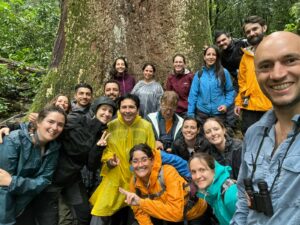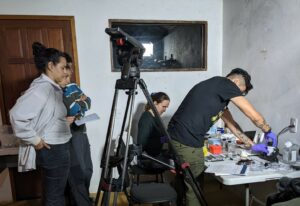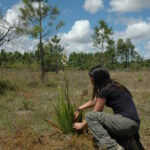
Members of the Antonelli Lab are fresh back from an incredible meeting in the heart of the Atlantic Forest in Brazil. Collaborators from Brazil, the UK, Sweden and many other countries met up at Sitio Bacchus, a private reserve in the Macae de Cima area, to talk science and survey the biodiversity. The meeting encompassed a BioBlitz and the forging of new project ideas, but the most ambitious aspect came from our project focused on entomopathogenic fungi, a diverse and unexplored group in this region.

Purpureocillium atypicola on a trapdoor spider. (c) João Araújo
Working with a Brazilian expert on insect-associated fungi based at the New York Botanical Garden, Dr João Araújo, members of the lab Dr Natalia Przelomska and Dr Oscar Perez Escobar set up an on-site DNA extraction and sequencing station for long-read sequencing of the freshly collected fungi-infected insects. Overcoming the challenges of working in situ, with limited equipment and power cuts, the team successfully extracted DNA from the samples and conducted the sequencing using an Oxford Nanopore MinION.

After producing around 1.1 GB of data, a quick BLAST search of the sequences confirmed that the team had indeed retrieved fungal DNA from the target samples – with the sequences showing high similarity to Beauveria and Cordyceps. Collaborators from the Czech Republic, Dr Pável Matos-Maraví and Mar Repulles, and Campinas, Dr Patricia Gueratto and Dr Patricia Avelino (from the Labbor group headed by Prof. André Freitas), also sequenced micromoth species collected at the site. Stay tuned as we explore the data further!

And as one meeting finishes, a workshop we held in August 2020 is just bearing fruit! After extensive discussion and analyses of Madagascar’s extraordinary biodiversity – its evolution, distribution, and use, and the current and future threats and opportunities – we are delighted to announce the publication of two reviews in the 2 December issue of Science. Congratulations to all lab members who put so much hard work into these two manuscripts, and we hope you will find the results informative and thought-provoking. You can read the two papers here:
Madagascar’s extraordinary biodiversity: Evolution, distribution, and use https://doi.org/10.1126/science.abf0869
Madagascar’s extraordinary biodiversity: Threats and opportunities https://doi.org/10.1126/science.adf1466
If you can’t access Science papers, then the accepted version of the manuscripts can be found in the Kew Research Repository: https://kew.iro.bl.uk/
